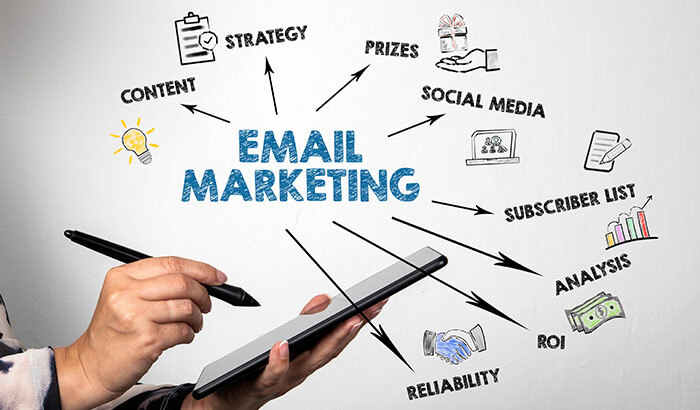Email marketing can be one of your business’s best time and money investments. This long-term strategy allows you to cultivate a list of willing customers who want to hear from your company.
How do you get from collecting emails to making thousands of dollars off a single campaign? We interviewed our expert on the subject and asked her some of the most relevant questions a small business owner will have when beginning their email marketing campaign.
Becca got her start creating emails for private clients when she was working her way through college. Early on, she knew she wanted to work in marketing. She found email marketing to be her favorite application due to its high return on investment and reliability.
Here is what she had to say about some of the most common questions about email marketing.
Question 1: Does email marketing have a high ROI? Will I get more sales/business from email marketing?
Answer:
Yes, I absolutely think every business should take advantage of email marketing. Regarding ROI, it doesn’t cost anything to send an email. You have to pay for some kind of ESP (email service provider) when you have a certain number of subscribers. But, besides that, it’s a very low investment, and you can make thousands of dollars from a single email.
The value of email marketing is that you own your list. You’re not reliant on outside platforms that constantly change. You don’t have any control over the algorithm of Instagram, Facebook, or whatever else you’re using. With email marketing, there isn’t a filter between you and your target audience.
Once you’ve created your email list, you own it. You’re in peoples’ inboxes. The data shows that most people check their emails multiple times a day. Email marketing is a personal way to connect with a customer that other platforms don’t allow.
Emailing gives you a direct communication method. Your company has a direct line to your customer without having to go through any hoops or needing to rely on outside forces.
Question 2: What is considered a good open rate?
Answer:
It depends on the industry. How engaged are your subscribers? How many emails do you send? How often do you send them? Generally, we shoot for a minimum of 25-30% open rate. Obviously, that varies from client to client.
Different industries have different goals because different benchmarks vary based on how your audience reacts to email. It’s not a one size fits all.
Your ESP should provide you with a comparison of your open rates between you and your peers. Some industries get a really high open rate. If you are in a top-performing industry, you should shoot for a higher open rate as well.
Question 3: How can I get recipients to open and read my email?
Answer:
Open rates depend, initially, on deliverability – whether it is going to land in their inbox. If we know it is going to land in their inbox, we focus on the subject line.
An open rate on a delivered email relies on the subject line. Nothing in the email is going to be seen unless your subscriber opens it. That subject line has to excite them and make them curious. You need to try and stand out as much as possible in their inbox because your customers are getting hundreds of other emails.
Question 4: What can a company do initially to get people to open up an email down the line?
Answer:
Make sure they immediately get an email. The first email that they get is going to be the one with the highest open rate because they are looking for that piece of value that you promised.
If they don’t get that email, they’re going to forget about you. They’re going to lose interest. So make sure that you immediately take advantage of that opportunity and send an email to them immediately, so you connect with them.
If you do this, they’re more likely to open your emails down the line because you made that connection right away.
Question 5: Why would anyone want to sign up for my email list?
Answer:
You have to provide some incentive that gives them value, whether that’s a discount, some kind of downloadable pdf, a challenge, a course, or an ebook.
You have to really get into your customers’ minds and understand where they’re at in their buyer’s journey, what their goals are, where their mindset is, and what would really excite them or make them want to give you their email.
Rather than seeing it as a way for your company to make money, you have to see it as an exchange of value.
Basically, look at it as their email is a form of currency. They’re paying you in exchange for a service or a good. The service or the good should be enticing. Just saying “sign up for our newsletter” is not good enough. You have to offer value.
Question 6: Would you ever suggest a company purchase a list?
Answer:
Absolutely not.
First of all, it’s legal to purchase an email list, but it’s illegal to use one without the consent of everyone on that list.
Secondly, those subscribers aren’t engaged. They don’t know who you are. They don’t know why you’re emailing them. You’re basically spamming. Not only could it be against the law, but it’s also unethical and will completely obliterate your reputation as a sender.
Your sender’s reputation is really important for determining if you’re going to land in the inbox or not. If you’re sending to a purchase list of people who don’t know who you are and haven’t provided consent to be emailed, then you’re most likely to end up in spam.
The most important thing to do is garner trust and establish value. You can’t cheat the system. Everyone has to start from scratch.
Question 7: How long does it take to make an email list?
Answer:
It depends on a lot of factors. I think the main factor is website traffic.
Many people will see your pop-up, embedded form, or whatever you use to get email addresses. A small percentage of those people that see it will actually sign up.
So, it’s a numbers game. The more traffic you have on your site, the more subscribers you’re going to get. The amount of traffic needed definitely depends on the industry.
A good opt-in rate is 3-6%. Obviously, that depends on the industry. It can be way lower or way higher. But most businesses are looking at 3% of the new people on their website signing up. And that’s people who land on your site that haven’t signed up for your newsletter already.
You’ve got to look at how many new sessions you are getting. 3% of that is how many people are going to be signing up per day.
Question 8: Is Email marketing only a long-term strategy?
Answer:
That depends. If you have good traffic to your site, you can build a list fairly quickly.
We just had a client where we’ve only had a pop-up on their site for a month, and they already have over 700 subscribers. It just depends on how many people are landing on your site and how valuable your opt-in incentive is.
Question 9: How important is design in email? How do I make it look good?
Answer:
Design is very important. People don’t read emails, they scan them – just like websites.
The design rules we use and the guidelines that we follow can make or break an email’s success.
There are several clients who we have optimized existing flows for recently and are making 4x more money. All we really changed was the design. So, it’s super important.
One thing I’ve seen people do is make the mistake of making their email too overwhelming: making it too busy, having too many pictures, having too many styles, having too many buttons. You want to keep it as simple as possible while conveying the message.
Question 10: How important are CTAs?
Answer:
They are the most important.
You definitely need to have CTAs in your email so you can call your audience to action.
It sounds obvious, but if you don’t tell them what to do, they’re not going to do what you want them to. Getting them to take a specific action is the ultimate point of the email.
Question 11: What things can I do to prevent people from unsubscribing?
Answer:
One thing is to avoid over-emailing. People will get tired if you send them too many emails.
You have to be considerate of your audience and appreciative of the fact that you’re a guest in their inbox. And so, if you’re sending way too many emails, people will unsubscribe. That’s the biggest reason I see.
Another reason people unsubscribe is that your company is not providing value. If with every single email you’re just pushing a product, your audience won’t likely be responsive. That’s where we see higher unsubscribe rates.
Another reason would be if the email doesn’t pertain to them. You want to segment your audience as much as possible so that you’re sending personalized messages that pertain to a specific group instead of just sending a generic message to an entire list every time.
Question 12: How can I keep my emails from being sent to spam?
Answer:
Sender reputation is the game.
Your sender reputation is how you’re perceived by email providers. These providers will determine whether you land in the inbox or whether you land in spam.
The lower your sender reputation, the less likely you’ll land in the inbox. So, Keep your reputation high.
Question 13: How do you get a good sender reputation for emails?
Answer:
Be mindful of how often you’re emailing people, how much value you’re providing them, and that you are regularly cleaning out your mailing list.
If you are new to email marketing, be sure to warm up your audience. If you have been gathering emails for a while but haven’t sent any out, you definitely don’t want to send your first email to everyone. Gradually increase the number of people you email and segment them as much as possible.
Question 14: What are common mistakes to make and how to avoid them?
Answer:
I would say emailing too much or not enough. I would not recommend emailing less than once a month because you lose your audience’s attention, and they forget about you.
You’ve also got to remember, they’ve got dozens of other companies emailing them so it’s likely that they don’t even know who you are if you don’t email them enough. You want to make sure they’re staying engaged. So, not emailing them enough can be just as detrimental as emailing them too much. Find that balance.
Usually, I’d recommend 2-3 emails a week for a segmented audience if you have a large list. Otherwise, I’d stick to one email a week.
Another common mistake is making emails too long or too short. Stick between 100-150 words – that’s super important. Again, people don’t read emails, they scan them.
Question 15: What are some good rules of thumb?
Answer:
I think the first thing is to try to remember that everything is about your customer and not your company. Always look at what you’re doing through their eyes.
Put yourself in their shoes. Try to understand where they are at mentally, what they’re thinking, what they feel, what they would appreciate, and what they wouldn’t.
When you do this, you start to share their interests, and you start seeing success. It just comes down to providing value.
I think that people just tend to think too much from the point of view of their company and not the customer. Being able to switch that mindset is when you’re going to start seeing success.
The more you try to serve your customers, the more they respond and appreciate you.
Making Email Marketing Work for You
Email marketing is a great way to nurture, retain, and sell to customers. Not only does it have a good return, but it’s relatively easy to run too.
If you want help getting this process up and running or even need someone to create some content for you to send to your subscribers, we’ve got your back!
Contact us today to get started on your email marketing adventures!







